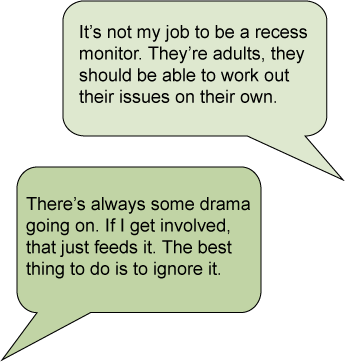What Can Managers Do?
It may be tempting to avoid getting involved when telecommunicators are clashing with each other or with supervisors or trainers.

But managers have an important role to play. If you take action, you can keep conflicts from spiraling out of control and help employees work toward resolution.3
What does it mean to intervene effectively in a conflict?
- Get involved early.
- You can avoid many full-blown conflicts by getting involved as soon as you see that two employees are on a collision course.
- Set the tone.
- How employees communicate about the problem makes a big difference in the outcome. Respect and civility are important.
- Read between the lines.
- You need to understand how everyone actually feels, not just what they say.
- Create a space for information sharing.
- Make sure everyone is working from the same facts and assumptions.
- Don't avoid confrontation.
- It may seem easier to smooth things over, but addressing the problem openly is the only way to solve it.
- Encourage problem-solving.
- Working together to find a solution that works for everyone is much more effective than fighting or negotiating.
Win-Win Conflict Management
The key words for effective conflict management are “win-win.” Your goal is always a solution that:
- is satisfactory for everyone involved in the conflict.
- supports the larger well-being of the organization.
- preserves or strengthens the personal relationships among all parties.
To get to win-win, start now. Lay the groundwork before conflicts start.
- Develop a fair, transparent, consistent process for conflict management. Stick to it and trust in the process will grow.
- Create a tolerant, respectful atmosphere. Treat differing feelings and preferences as equally legitimate.
- Get to know your employees well. When compromises are necessary, this will help you understand what is most important to each of them.
- Build creative problem-solving skills. A win-win solution often comes from the people in conflict themselves; validating brainstorming and out-of-the-box thinking can pay off in conflict situations.
What Would You Do?
Lisa and Darla were hired at the same time and had been good friends for years. Darla was technically senior, but she usually let Lisa have her choice of shifts, because Lisa was caring for her sick mother and needed flexibility to take her to appointments. Then Darla got into a new relationship. Her personal life started getting busier, and she stopped checking with Lisa before choosing shifts.
Both Lisa and Darla came to their manager, Karen, to complain. “I need to take my mom to the doctor, and Darla is taking the shift I need just to be with some guy!” Lisa said.
“I let her have the shifts she wanted for years, and now I just want a turn,” Darla said.
Other employees were beginning to gossip and take sides, and Karen knew that this problem was likely to get worse. What would you do in Karen's position?
What Karen Did
Karen decided to start by talking to Darla and Lisa individually. She tried to convince each of them to give in, but quickly realized that neither of them was going to budge and that forcing the issue was going to cause a lot of bad feeling. Next, Karen called both Darla and Lisa in to her office and asked them to really listen to each other. It became clear that there was anger and hurt feelings on both sides.
As they continued talking, Karen saw that most of the problems were centering on two shifts that Lisa often needed in order to be able to take her mother to physical therapy. Lisa was furious that Darla had taken those shifts a couple of times, leaving Lisa to scramble to get her mother to her appointments. Although Darla continued to feel that she had a right to sometimes take the shifts that worked better for her, she also felt bad, especially about leaving Lisa with no option on short notice. On her own she offered in the future to give Lisa plenty of warning if she was going to want to take one of those shifts. That was enough for Lisa to accept and from there they were able to create a “new normal” for working together on scheduling.
